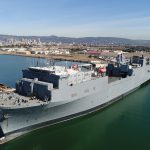
Annual letter to shipping agents and interested parties to provide information about new regulations and reminders about reporting requirements.
Please ensure information regarding California’s Marine Invasive Species Program is distributed to all vessels that arrive at a California port. This letter will address:
- General Reporting Information
- Annual Vessel Reporting Form (AVRF)
- Ballast Water Management Report (BWMR)
- Notifications and Alternatives
- Golden Mussels
- Vessel Inspections
- Data Summaries
Please find a detailed description of the items below:
Submit Report to:
Online: MISP.IO
Email: bwform@slc.ca.gov
FAX: 562.499.6444
Thank you for your attention to this matter. Please contact Chris Scianni with any questions at MISP-EPM.Public@slc.ca.gov or 562.499.6390.
General Reporting Information
Annual Vessel Reporting Form (AVRF)
The Marine Invasive Species Program Annual Vessel Reporting Form (AVRF) must be submitted once per calendar year, at least 24 hours prior to a vessel’s first arrival of the year at a California port. The AVRF must be submitted through the web-based platform https://www.MISP.IO. Note the AVRF can be submitted earlier during the calendar year (e.g., submitted in January for a first arrival in March), if desired, and can be submitted by anyone affiliated with the vessel (e.g., ownership, management, crew, agent).
Vessel owners or operators that are unable to submit the AVRF via MISP.IO due to logistic or technological challenges should contact the Marine Invasive Species Program at cslc.misp@slc.ca.gov as soon as possible to inquire about AVRF submission alternatives.
Ballast Water Management Report (BWMR)
All vessels that arrive at a California port must submit the Ballast Water Management Report (BWMR) 24 hours prior to arrival at each port in California. If a vessel’s voyage is less than 24 hours, the BWMR shall be submitted upon departure from the last port of call. A corrected BWMR must be submitted if ballast water management or discharge information changes after initial submission.
Vessels moving from one California port to another are required to submit a separate BWMR for each arrival port. For reporting purposes, the following places are recognized as separate ports by the Marine Invasive Species Program. All terminals, berths, and anchorages within each port area are considered a part of that port.
- Humboldt Bay Harbor (including Eureka)
- Port of Sacramento
- Port of Stockton
- Port of San Francisco, including all San Francisco Anchorage Locations
- Carquinez (includes all marine oil terminals and anchorages in the Carquinez Strait, extending east to the Antioch Bridge)
- Port of Richmond
- Port of Oakland
- Port of Alameda
- Port of Redwood City
- Moss Landing Harbor
- Monterey Harbor
- Santa Barbara Harbor
- Port Hueneme
- Marina del Rey Harbor
- El Segundo
- Los Angeles/Long Beach Port Complex (including all anchorage locations within the breakwater)
- Avalon/Catalina
- Port of San Diego (including Point Loma)
California requires vessels to use the U.S. Coast Guard Ballast Water Management Report (OMB No. 1625-0069).
Notifications and Alternatives
Any questions or inquires, including requests for alternative reporting submission, notification of an inoperable ballast water treatment systems, or issues with the online reporting portal should be sent to cslc.misp@slc.ca.gov. Staff will respond accordingly.
Golden Mussels
The highly invasive freshwater golden mussel was detected in Stockton in October 2024, and in a few other locations during the following months (please see the California Department of Fish and Wildlife’s Golden Mussels website for an up-to-date map). Our MISP staff have created an outreach flier to share with vessel personnel to raise awareness, describe what the mussels look like, and provide instructions on how to report a sighting. Please share this <a “Read or download the flier” href=”https://slcprdwordpressstorage.blob.core.windows.net/wordpressdata/2024/12/MISP-Golden-mussel-flyer_webacc.pdf”>flier with your vessels so they know what is expected of them.
Vessel Inspections
Please be aware that our field operations staff board and inspect at least 25 percent of all vessel arrivals in California. During these inspections, our staff assess compliance with the California Marine Invasive Species Act and all associated regulations, provide outreach regarding California’s biofouling and ballast water requirements, and answer any questions the crew may have. If you have any questions about our inspections, please contact us at cslc.misp@slc.ca.gov.
Data Summaries
Commission staff have created an interactive vessel traffic and ballast water management data dashboard for the public to use. The interactive data dashboard is updated quarterly and can be found at https://misp-cslc.hub.arcgis.com/.
Please visit https://www.slc.ca.gov/misp/ for more information about the Marine Invasive Species Program and the regulations we administer.
Thank you for your attention to this matter. Please contact Chris Scianni with any questions at MISP-EPM.Public@slc.ca.gov or 562.499.6390.

